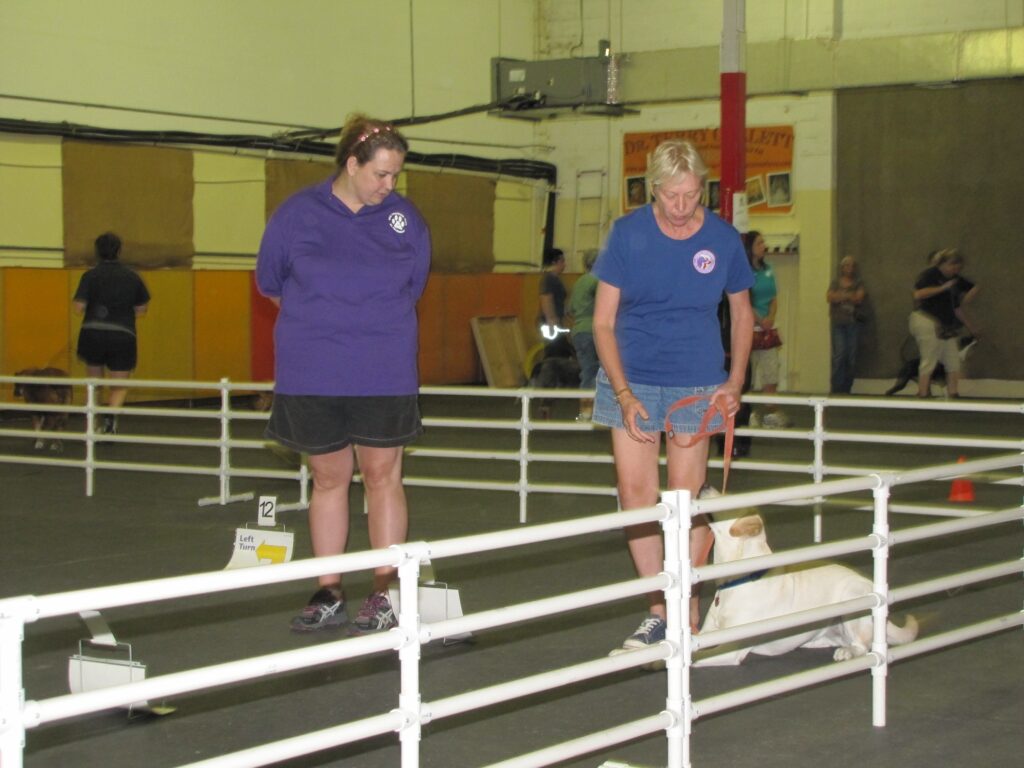Barks Blog
Working Dogs Want to Have Fun, Too

Off-duty working dogs enjoy many of the same dog sports as pet dogs … but training for and competing with a career dog raises some interesting questions.
Deni Elliott, whose guide dog, Alberta, has nearly earned her Rally Advanced Excellent title, but their start in the sport was a bit bumpy. Deni needs a sighted guide (human) to read the signs to her, but that was the easy part. The biggest adjustment was for Alberta, who had to figure out that, not only was she not supposed to guide Deni around the obstacles, she was actually supposed to relax and have fun — this was not work! Once she got that concept, she was off and running. (You can read more about their Rally adventure on the Guiding Eyes for the Blind blog).
For many working dogs, intense focus on the handler and anticipation of the handler’s needs are integral to the job. Puzzling your way through a Rally course together, paying attention to the nuances of running an agility course, or perfectly timing a leap for a Frisbee — goals that have nothing to do with the handler’s needs — requires a different kind of focus from the dog and a different style of communication for the team. Working together in this way can enhance and expand the handler-dog communication and bonding.
A shift in mindset is not the only issue that arises when a service dog team turns to dog sports looking for fun, exercise, and a new dimension to the partnership. Sometimes, the way we train for sports or other leisure activities can conflict with training the dogs have received for their work.
One challenge that many service dog partners face daily is persuading their Labradors or goldens not to vacuum up bits of food that they encounter on the floor. Deni has worked long and hard on this with Alberta. Many pet dog owners, myself included, have also worked hard to discourage our dogs from eating everything in sight. This training clashes with a common technique in pet-dog-training classes: Tossing treats onto the floor. I have attended a number of classes where this techniques has been used.
- A puppy class where we played “find it” by tossing treats
- Agility classes where treats are tossed onto a target, then at increasing distances, to encourage the dog to touch a target
- Shaping classes where treats are tossed so that the dog will leave and then return to an item, providing additional opportunities to click and reward
While I see the reasoning for this technique, I am also curious about alternative methods trainers use that avoid the treats-on-the-floor conundrum. I don’t intend this comment as criticism, but rather as a way to start a conversation: I am sure that we can come up with plenty of other ways to direct a dog’s attention toward and away from a target. A couple ideas that come to mind: remote treat dispensing devices or using a verbal marker or clicker as a bridge until treat is hand-delivered. One instructor suggested a “release” word or cue to let the dog know that she’s not working and different rules apply.
As dog professionals and dog lovers, I believe that we share the goal of encouraging people to spend more time having fun with their dogs and building better communication and stronger bonds. I’d love to use this blog as a forum for brainstorming ways to make some dog sports and classes more accessible to handlers with a variety of limitations and different goals — wheelchair users or clients with limited mobility, for example. Some dog owners might want to participate in dog sports for fun and bonding, but be less concerned about honing their skills to competition level. Other handlers (or dogs) might be older and slower-moving — though still able to enjoy running an agility course or doing nose work. I’d love to see a conversation among PPG trainers about how you address these populations in your work, as well as ideas for ways to work around training techniques or mindsets that could get in the way of a working dog-and-partner team having fun in dog sports.
How about it? How do you adapt your approach in a class with a service dog? What classes do you offer that target unique populations of dogs or handlers?

